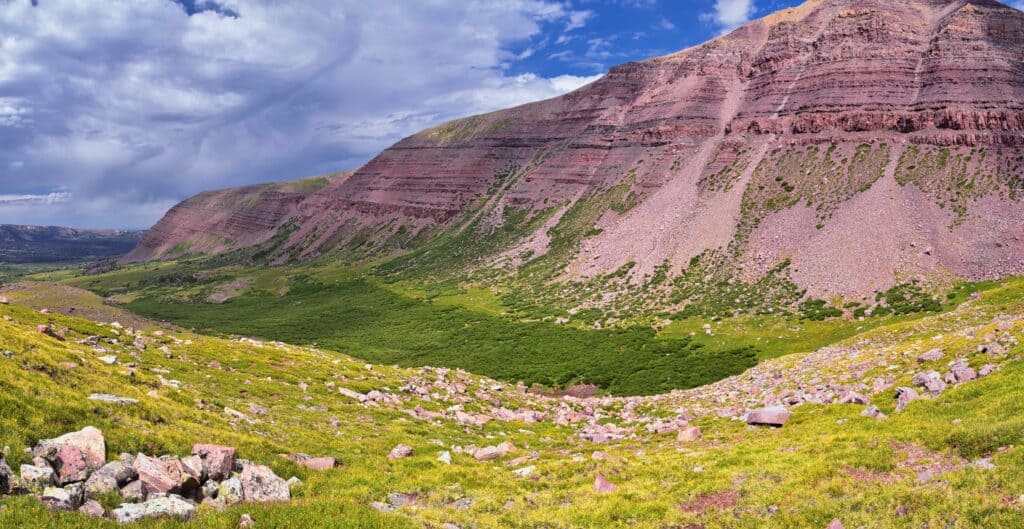Utah, the land of breathtaking landscapes and awe-inspiring natural wonders, is a state that never fails to captivate the imagination. From the towering peaks of the Rocky Mountains to the vast expanses of the Great Salt Lake, Utah’s diverse geography is grand. One aspect that often piques curiosity is the state’s size. What is the distance from the northernmost point of the state to the southernmost tip? In this article, we unravel the vertical majesty of a treasured state. Get ready to uncover the answer to the question, “How tall is Utah?”
Height of Utah

King’s Peak is the tallest mountain in Utah. It’s also one of the state’s most popular hiking destinations.
©Jeremy Christensen/Shutterstock.com
Utah is known for its diverse topography, including high-elevation areas such as the Rocky Mountains and the Colorado Plateau. The state is home to numerous mountain ranges, canyons, and high plateaus. For example, the highest point is Kings Peak. It stands at an elevation of 13,534 feet (4,125 meters) above sea level.
Utah’s North-to-South Distance

Utah shares a border with Colorado, Wyoming, Nevada, Idaho, and Arizona.
©Alexander Lukatskiy/Shutterstock.com
When considering the total distance from the northernmost point to the southernmost tip, Utah measures approximately 350 miles (560 kilometers). This measurement takes into account the diagonal line that stretches from Idaho in the north to Arizona in the south.
Exploring the Landscapes
Northern Utah
Utah’s diverse landscapes contribute to its considerable north-south distance. In the north, the state boasts the majestic Uinta Mountains, reaching heights of over 13,000 feet (3,962 meters). These snow-capped summits offer a dramatic backdrop to the expansive forests and alpine meadows that dot the region.
Idaho Border to Central Utah
From the Utah-Idaho border to the central portion of the state, the Wasatch Range dominates the skyline. Prominent peaks such as Mount Timpanogos tower over 11,000 feet (3,353 meters) above sea level. Spanning approximately 160 miles (260 kilometers), the Wasatch Mountains are known for their world-class ski resorts and picturesque canyons. They offer outdoor enthusiasts a playground for adventure.
Central Utah
Central Utah unveils a stark contrast to its expansive deserts. Points of interest include the iconic Monument Valley and the vast expanse of the San Rafael Swell. These arid landscapes showcase the state’s unique geology. Towering mesas and sculpted sandstone formations have been shaped by millions of years of natural erosion.
Utah’s Southern Extremes
As we venture southward, the landscape transitions into the stunning red rock formations of the Colorado Plateau. Here, we encounter world-famous national parks, including Zion National Park, Bryce Canyon National Park, and Capitol Reef National Park. These geological marvels showcase towering cliffs, intricate slot canyons, and natural arches, leaving visitors in awe of Mother Nature’s artistic prowess.
As we reach the southernmost point of Utah’s north-south distance, we find ourselves at the Arizona-Utah border. Here lies the captivating beauty of the Glen Canyon National Recreation Area, home to the iconic Lake Powell. This vast reservoir stretches across the border, offering visitors an opportunity to witness the harmonious merger of water and desert landscapes.
In Conclusion
Utah’s highest point of 13,534 feet and total north-to-south distance of approximately 350 miles is a testament to the state’s remarkable topographical majesty. From the towering peaks of the Uinta and Wasatch Mountains in the north to the captivating red rock formations of the Colorado Plateau in the south, the diverse landscapes offer a captivating journey through nature’s finest creations. Whether you find yourself exploring the alpine meadows, skiing down pristine slopes, or wandering through the sculpted canyons, Utah’s vertical beauty will leave an indelible mark on your soul.
The photo featured at the top of this post is © Fotos593/Shutterstock.com
Thank you for reading! Have some feedback for us? Contact the AZ Animals editorial team.







